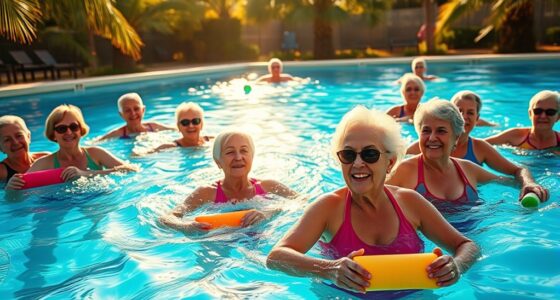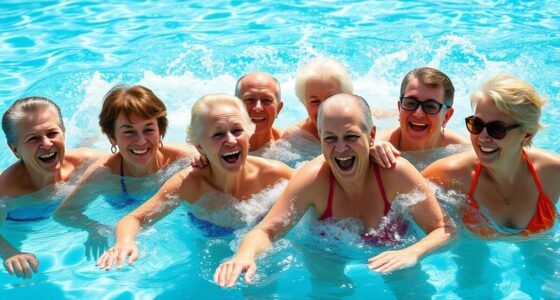Senior workouts can empower you by boosting strength, flexibility, and balance, leaving you feeling unstoppable. Begin with warm-ups to prepare your muscles and elevate your heart rate. Engage in simple strength exercises tailored to your level, while maintaining proper posture to prevent injuries. Incorporate breathing techniques for relaxation, and consider group activities to foster connections. Stay hydrated and celebrate your progress. Each step you take leads you to greater fitness. Discover more ways to enhance your routine!
Key Takeaways
- Incorporate warm-ups and stretching to enhance flexibility, prevent stiffness, and prepare muscles for activity, reducing injury risk.
- Engage in strength exercises like chair stands and arm curls to boost muscle strength, stability, and overall fitness.
- Focus on proper posture during workouts to optimize performance and maintain balance, enhancing daily functional movements.
- Utilize breathing techniques to maximize oxygen delivery, promote relaxation, and improve overall workout effectiveness.
- Participate in group exercises for social connections, accountability, and to elevate mental well-being while enjoying the fitness journey.
The Importance of Warm-Ups in Senior Fitness
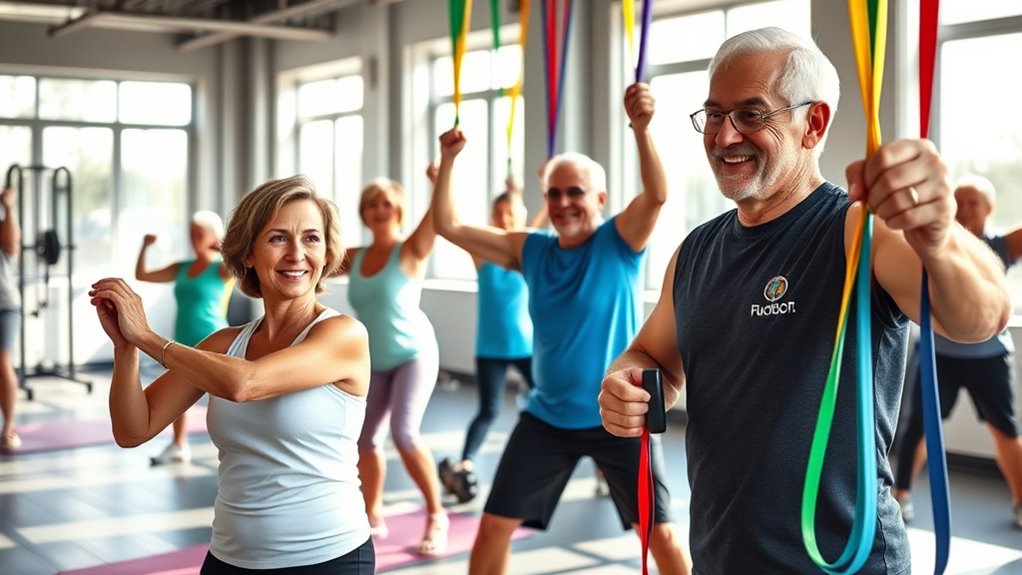
When you warm up before strength exercises, you’re not just getting your heart rate up; you’re also preparing your muscles for activity and considerably reducing your risk of injury.
Warming up not only elevates your heart rate but also prepares your muscles and minimizes injury risk.
A proper warm-up can include movements like a march and step touch, which engage your muscles and improve posture. Adding arm movements helps loosen shoulder tension and increases your overall mobility, especially important as you age.
Incorporating seated leg lifts and calf stretches targets the quads and promotes flexibility in your lower body.
Don’t forget to stretch after your warm-up and workout, holding each stretch for 15 to 30 seconds. This practice is vital for improving flexibility and aiding recovery, making it an essential part of your fitness routine. Additionally, maintaining proper hydration is crucial for overall muscle function and recovery during your fitness journey.
Engaging Strength Exercises for All Levels
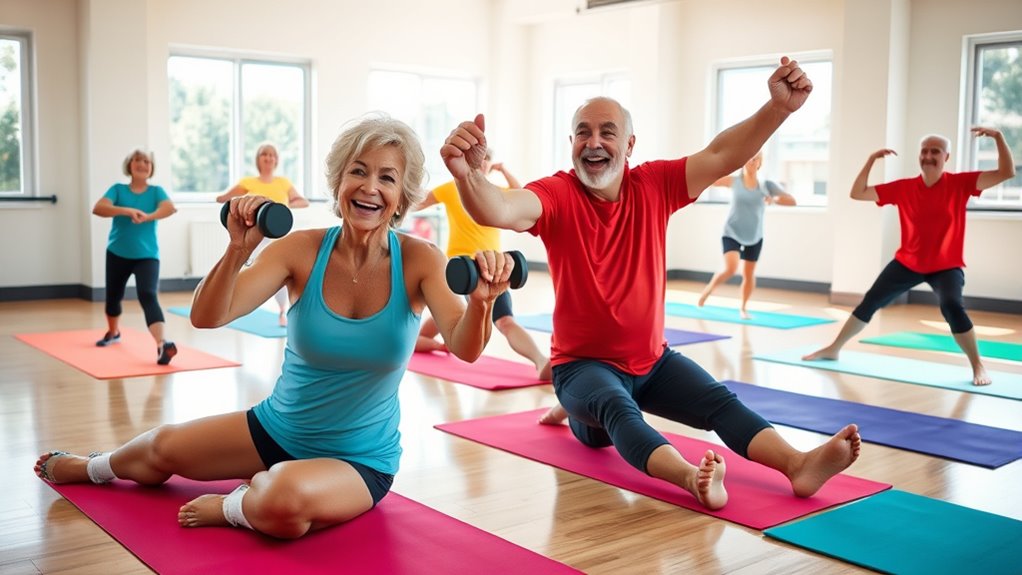
Engaging in strength exercises can greatly enhance your overall fitness, regardless of your current ability level. Simple movements like arm curls and chair stands can boost your muscle strength and keep you functional in daily activities. Try incorporating chair dips and side leg raises to target specific muscle groups, promoting balance and stability. You can easily modify these exercises based on your comfort level. Regular physical activity can also help reduce anxiety and improve mood, especially for seniors facing cognitive decline. Furthermore, activities that promote muscle strength are essential for maintaining independence as we age. Engaging in safe exercise environments is crucial to prevent injuries while working out. Additionally, maintaining good indoor air quality can support a healthier exercise environment, enhancing your overall workout experience.
For added engagement, use a step touch to mix in some cardio while you’re at it. Aim for sets of 10 reps with focused breathing to improve your posture and reduce fall risks. Additionally, pairing your workouts with a healthy breakfast can provide the necessary energy and nutrients to support your fitness routine. Plus, working out in groups can make these sessions enjoyable, encouraging you to stay committed to your fitness journey.
Flexibility and Stretching: Keys to Mobility

Incorporating flexibility and stretching into your fitness routine complements strength exercises by enhancing your overall mobility.
Daily stretching can help you maintain balance and reduce the risk of falls, which is vital as you age. Aim to hold each stretch for 15 to 30 seconds, focusing on pulling your toes back to improve leg flexibility. Additionally, regular stretching can prevent stiffness in muscles and joints, which is crucial for maintaining mobility as you grow older. Engaging in mindfulness practices can also enhance your self-awareness and improve your connection to your body during these stretches. Furthermore, improving your flexibility can also contribute to better air quality in your environment, as it encourages you to engage in activities that require movement and ventilation.
Here are some benefits of regular stretching:
- Enhances overall flexibility and mobility
- Promotes relaxation and recovery after workouts
- Improves circulation and relieves muscle tension
- Prevents stiffness in muscles and joints
- Supports a greater sense of well-being
Additionally, engaging in activities that promote digital literacy programs can enhance your communication skills and help reduce feelings of isolation. It’s important to remember that self-care practices are essential for maintaining mental and emotional well-being as you incorporate physical activities into your routine.
The Role of Proper Posture in Workouts
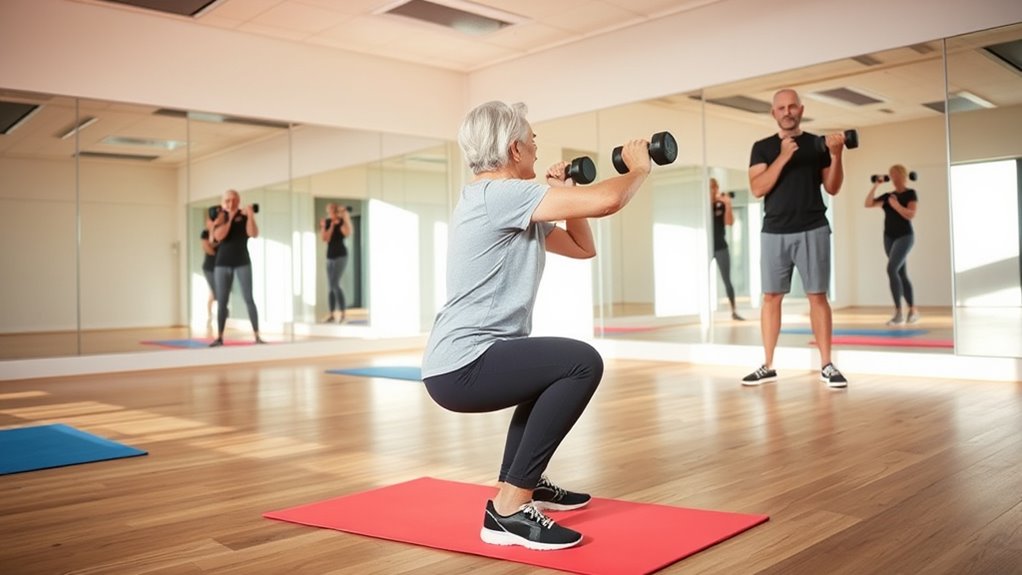
Proper posture during workouts isn’t just about looking good; it plays an important role in preventing injuries and optimizing your performance. Make sure you maintain proper alignment to distribute weight evenly across your joints and muscles. Good posture engages your core, improving balance and stability, which is crucial for safe exercise execution. Focusing on your posture can enhance the effectiveness of each movement, leading to greater strength gains. Regularly practicing good posture also boosts flexibility and contributes to better functional movement in daily activities. Additionally, maintaining good posture can help in reducing risk of long-term musculoskeletal issues. Furthermore, adopting a growth mindset can empower you to overcome challenges and push through plateaus in your fitness journey. Engaging in regular physical activity can also promote emotional well-being, enhancing your overall fitness experience. Moreover, cultivating a strong sense of mental resilience can further support your commitment to fitness and well-being. It’s also important to recognize that sustainable fashion can inspire workout gear choices, promoting comfort and style during exercise.
| Benefits of Good Posture | How to Maintain It |
|---|---|
| Prevents injuries | Align your body correctly |
| Improves balance | Engage your core |
| Enhances strength gains | Focus on posture cues |
Breathing Techniques to Enhance Your Routine
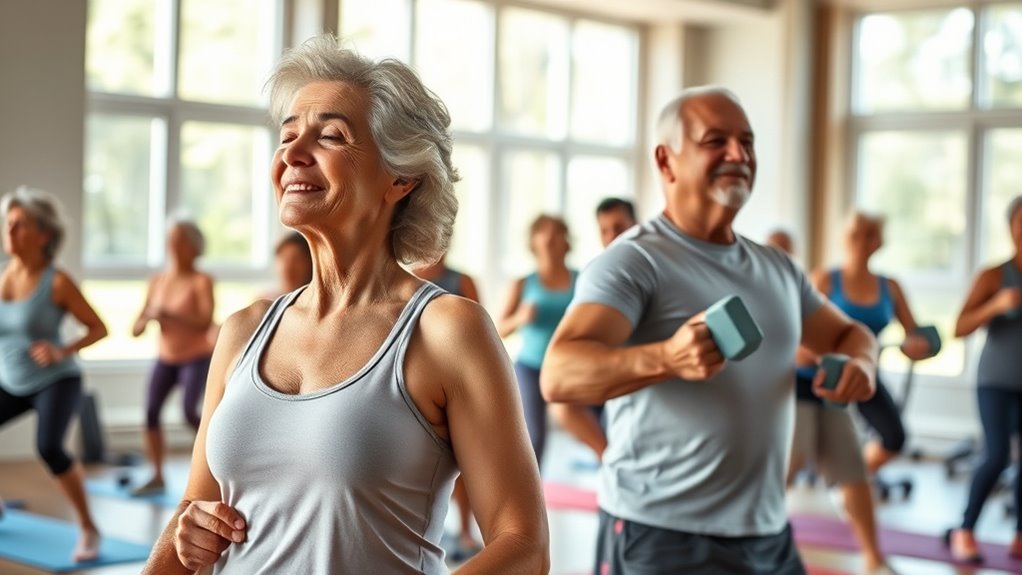
Breathing properly during your workouts is essential for maximizing your performance and relaxation.
By focusing on your breathing rhythm—inhale through your nose and exhale through your mouth—you can enhance oxygen delivery to your muscles. Incorporating deep breaths will also help you feel calmer and more focused, making your routine even more effective. Additionally, maintaining skin hydration and moisture retention through proper breathing techniques can further support your overall wellness during exercise. Engaging in mindfulness practices can also complement your breathing techniques, promoting a more holistic approach to your fitness routine. Furthermore, understanding the importance of hydration and nutrition can significantly impact your energy levels and endurance during workouts. Using essential oils like lavender oil can also promote relaxation and enhance your breathing experience. To further support your wellness, consider the watering techniques for your indoor plants, as maintaining a healthy environment contributes to overall well-being.
Importance of Proper Breathing
How can mastering the art of breathing transform your workout routine? Proper breathing techniques can greatly enhance your performance and endurance.
Every time you focus on your breath, you release benefits such as:
- Improved oxygen flow during exercises
- Greater focus and relaxation through rhythmic breathing
- Reduced stress and increased lung capacity with deep diaphragmatic breathing
- Better awareness of your body, leading to improved posture
- Enhanced overall well-being by incorporating breathing into daily routines. Additionally, using essential oils like eucalyptus oil can help clear your airways, further improving your breathing efficiency during workouts. Practicing mindfulness techniques while breathing can also enhance your mental focus, making every workout feel more impactful. Furthermore, maintaining clean air quality in your workout environment can significantly support your breathing effectiveness.
Breathing During Exercises
Mastering breathing techniques can greatly enhance your exercise routine. When you’re breathing during exercises, focus on inhaling during the easier phase, like lowering weights, and exhaling during the exertion phase, such as lifting. This rhythm helps maintain your energy levels and guarantees better oxygen flow to your muscles.
Engaging your core while breathing deeply stabilizes your body and improves posture, which is vital for safety and effectiveness. Regular practice of controlled breathing can lower your heart rate and promote calmness, making your workouts feel more manageable.
Additionally, focused breathing can boost endurance, allowing you to perform more repetitions and maintain better form throughout your workout. Incorporating these techniques will leave you feeling unstoppable!
Relaxation Through Deep Breaths
While you engage in your workout, incorporating deep breathing techniques can greatly enhance your sense of relaxation and focus.
Here are some benefits of deep breathing to reflect on:
- Reduces stress: Deep breathing calms your mind, easing tension during workouts.
- Enhances oxygen flow: Focusing on each breath boosts oxygen to your muscles, improving performance.
- Promotes better posture: Engaging the diaphragm helps maintain stability during strength training.
- Supports recovery: Consistent deep breathing aids flexibility and recovery during post-workout stretches.
- Achieves calmness: Inhaling slowly through your nose and exhaling through your mouth fosters a focused mindset.
Building Lower Body Strength for Better Stability

Building lower body strength is crucial for enhancing stability and reducing the risk of falls as you age. Engaging in exercises like chair stands and leg raises helps you strengthen key muscle groups, such as your glutes, hamstrings, and quadriceps.
When you build these muscles, you improve your mobility and balance, making it easier to move right through daily tasks. Regular practice of lower body exercises can enhance your functional abilities, allowing you to maintain independence.
Remember to incorporate proper breathing techniques during your workouts; this not only boosts your performance but also promotes relaxation, making your sessions more enjoyable.
Consistent lower body routines can greatly improve joint stability and muscle coordination, essential for staying active as you age.
Fun Group Exercises to Foster Community
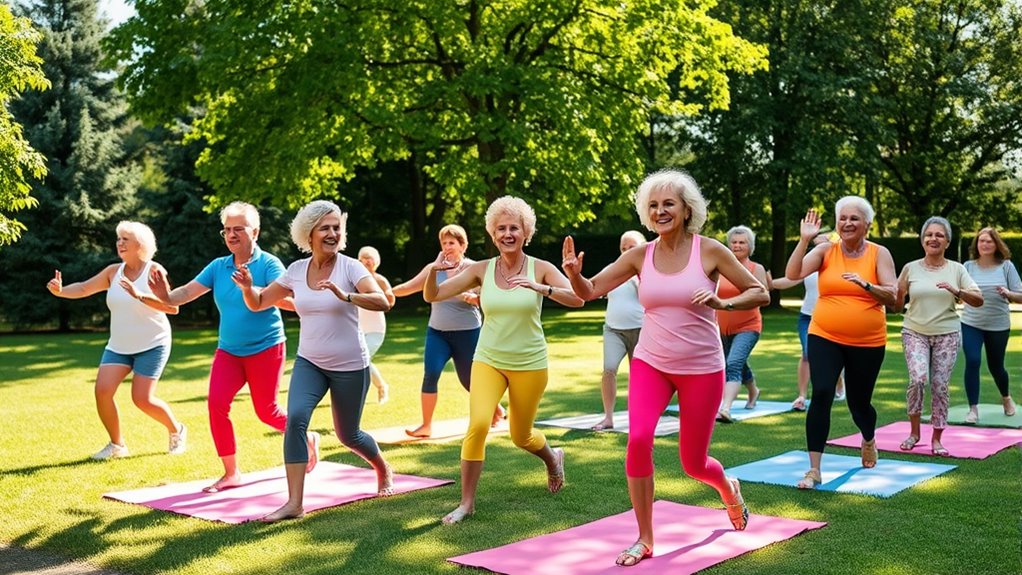
Joining fun group exercises can really help you build social connections while getting fit.
When you work out together, you boost each other’s motivation and create a supportive environment.
Plus, adding some laughter makes the experience enjoyable, turning exercise into something you look forward to.
Building Social Connections
How can group exercises transform your fitness routine into a vibrant social experience? By participating in fun group workouts, you’re not just improving your health; you’re also building social connections. Engaging in activities with others creates a supportive environment that can lead to lasting friendships.
Consider these benefits:
- Share laughs and light-hearted moments to enhance camaraderie.
- Bond over shared experiences in chair yoga or group walks.
- Encourage each other in partner strength exercises for accountability.
- Combat feelings of loneliness through regular social participation.
- Elevate your mental well-being and quality of life.
With every session, you’ll find that exercise becomes more enjoyable, making it easier to stay committed to your fitness goals while fostering a sense of community.
Enhancing Group Motivation
Group workouts not only strengthen social bonds but also ignite motivation among participants. When you join in fun exercises, like dancing to upbeat music or participating in light-hearted challenges, you’ll notice a turn around in your energy levels.
The support from your fellow participants makes you feel less isolated and more inspired to push yourself. Regular group sessions help you stick to your fitness routine, as having that social support is key.
Encourage each other by sharing experiences and celebrating achievements, no matter how small. This creates a positive atmosphere where everyone thrives.
Modifying Workouts for Individual Needs
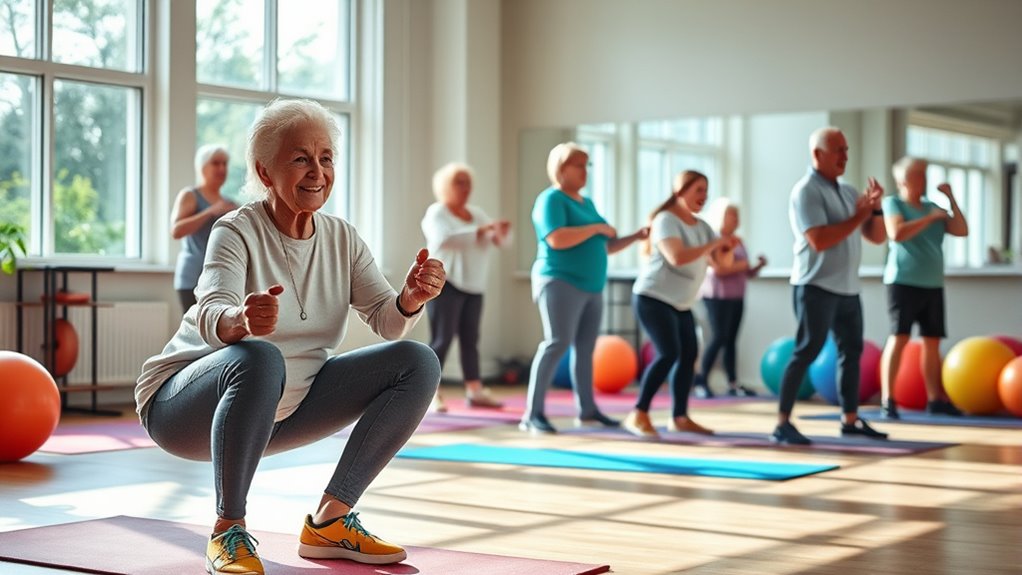
When it comes to modifying workouts for individual needs, it’s essential to adjust the intensity, duration, and type of exercises to guarantee everyone can participate safely and effectively.
Here are some key considerations to keep in mind:
- Use lighter weights or modified versions of strength exercises.
- Incorporate chair dips with a wider chair for added stability.
- Listen to your body; don’t hesitate to take breaks.
- Opt for seated variations of standing exercises if needed.
- Encourage consistent feedback to tailor workouts for individual capabilities.
Staying Hydrated: The Importance of Water

Staying hydrated is essential for your overall health, especially as you age. Water makes up about 60% of your body and plays a significant role in maintaining bodily functions.
Dehydration can lead to serious health issues like confusion and kidney stones, so it’s important to drink water regularly throughout the day. The National Institute on Aging recommends you aim for at least 8 cups (64 ounces) of fluids daily, with water being your best choice.
Celebrating Progress and Encouragement in Fitness

Recognizing your progress in fitness, no matter how small, can greatly boost your motivation and keep you committed to your exercise routine.
Celebrating progress is essential for maintaining a positive mindset and encourages you to keep moving forward. Here are some ways to acknowledge your achievements:
Celebrating your progress fosters a positive mindset and motivates you to continue advancing in your fitness journey.
- Track improvements in strength, flexibility, or endurance.
- Share milestones with workout buddies or in group classes.
- Celebrate personal victories, like completing a challenging exercise.
- Enjoy encouragement from trainers and peers during workouts.
- Reflect on how far you’ve come and set new goals.
Frequently Asked Questions
What Is the Number One Exercise Seniors Should Do?
The number one exercise you should do is strength training. It’s essential for building muscle mass and improving bone density.
Engaging in strength exercises twice a week can greatly reduce your risk of falls while enhancing balance and coordination. Simple moves like chair stands and arm curls require minimal equipment and guarantee safety.
What Is the Number 1 Exercise to Increase Balance in Seniors?
Picture a tree standing tall, its roots firm in the ground. That’s how you should feel when you practice the single-leg stand, the top exercise to boost your balance.
By lifting one foot and holding your stance, you engage your core and lower body, grounding yourself like that sturdy tree. Start with support, aiming for 10 to 30 seconds.
As you grow stronger, challenge yourself without support, building both confidence and stability.
What Is the AARP #1 Exercise for Seniors?
The AARP’s #1 exercise for seniors is walking. It’s a simple, low-impact activity that fits easily into your daily routine.
Walking enhances your cardiovascular health, strengthens your bones, and boosts your mental well-being. By aiming for at least 150 minutes of moderate walking each week, you can greatly reduce your risk of chronic diseases.
Plus, you can tailor your walking routine to suit your fitness level and enjoy social interactions with others.
What Is the Best Workout Routine for Seniors?
Did you know that regular exercise can reduce the risk of falls by up to 30% in seniors?
To create the best workout routine, mix strength training, flexibility exercises, and aerobic activities. Aim for strength training twice a week, with 10-15 reps focusing on major muscle groups.
Incorporate daily stretching for flexibility, and target at least 150 minutes of moderate aerobic activity weekly.
Always listen to your body and adjust exercises as needed.
Conclusion
You’ve released your potential and embraced a vibrant voyage in fitness! With warm-ups to wake up your muscles and strength exercises to strengthen your spirit, you’re crafting a cornerstone of confidence. Flexibility fuels freedom, while posture promotes power and breathing boosts balance. Join joyful group gatherings, adapt activities to your abilities, and stay hydrated for health. Celebrate every small success as you stride towards unstoppable strength, shining with satisfaction and surrounded by supportive smiles!



